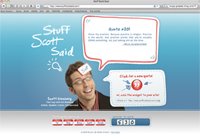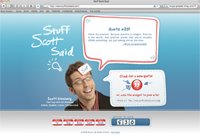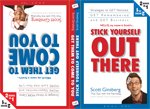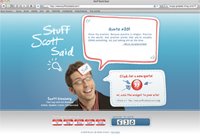 As the evil killer lunges towards Watson’s neck, Sherlock Holmes grabs the arm of his attacker, stopping the invisible dagger millimeters before slicing the jugular of his faithful companion.
As the evil killer lunges towards Watson’s neck, Sherlock Holmes grabs the arm of his attacker, stopping the invisible dagger millimeters before slicing the jugular of his faithful companion.
“How did you see that?” Watson gasps.
“Because I was looking for it,” Holmes replies.
LESSON LEARNED: Awareness is power.
THE GOOD NEWS IS: Creativity isn’t as hard as people convince themselves it is.
Let’s explore seven ways for getting so many creative ideas that you’re forced to hire a college intern:
1. Call dibs. Learn to recognize, nurture and capture inspiration when it arises. Open your receptors to the subtleties around you. Trigger your receptive capacities and respond spontaneously. Then, the moment you think to yourself, “Hmm … no one else seems to have noticed that…”
Take it. It’s yours. Get it down on paper. Writers keepers, losers weepers, sucka! Remember: If you don’t write it down – it never happened. When creative ideas are up for grabs, are you calling dibs?
2. Be a ceaseless, shameless thief of good ideas. I steal material from everybody. All the time. Wherever I go. There’s nothing that isn’t fair game. When an idea crosses my path, I am ruthless. My sixth sense will pick up on ideas before they even hit the ground.
And I will seize them with the devastating swiftness of creative ninja who’s so fast and efficient, that by the time his opponent realizes he’s just been decapitated, the ninja is already down the street drinking green tea. That’s how I roll. You’ll never see me coming, you’ll never see me leave.
That’s what good ninjas practice: The art of invisibility. And that’s the difference maker. Unlike that population of plagiarists, hacks and bullshit artists disguised as writers, I actually know how to steal properly.
That’s the second half of the equation. See, once a ninja has come through town, he leaves without a trace. He burns himself completely. Almost like he’s stolen your car, and within 24 hours, it has a new paint job, new rims, new tires, chopped up into a convertible and ultimately unrecognizable to the previous owner.
That’s how you steal ideas properly. It doesn’t matter IF you steal it – it matters WHAT you do with it WHEN you steal it. How toned is your creative thievery muscle?
3. Allow inspiration to clarify. Your job is simple: Listen and capture. That’s it. The rest of the time is waiting. Letting ideas simmer and breathe. Allowing multiple dimensions to arise. Alchemizing and coalescing related fragments. Concocting potions.
Crafting mosaics of words, phrases and sentences. Trusting your resources, believing that you’re richly support and having faith that other ideas will attach themselves. How many of your million-dollar ideas squander under the weight of creative impatience?
4. Be open to ideas from everyone and everywhere. In his album, On Comedy, George Carlin said, “Be actively interested and observant, but absorb things in spite of your attention. You need a wide range of things so you can make contrast.”
Lesson learned: Get the creative radar sweeping faster. Always be on the lookout for underlying value. Remember: Abundance is a function of receptivity. What unexpected ideas did you reel in today?
5. Become conscious of your own thought process. That way, you can build a repeatable success process for finding new material. Let’s look at two ways to do so. First, keep a running list of all the questions you ask yourself during the creative process. On my list of 7000, a few of my faves are, “Now that I have this, what else does this make possible?” and “Is everything you know written down somewhere?”
Second, map out your personal approach to entertaining ideas. (Personally, I undergo a process of thirteen steps). This exercise is fun, interesting and educational. And the secret behind both of these examples is twofold: (1) They help you become intimate with your creative experience, and (2) They help people see how your brain works.
These are invaluable assets as a thought leader. Because people don’t care what you know – only how you think. How could you become more conscious of your own thought process?
6. Put things under a microscope. The closer and deeper you probe, the more ideas you get. It’s magical. For example, wordsmithing is an amazing technique for uncovering native meaning to ideas we take for granted. Personally, I do a little wordsmithing every day.
Another approach is making lists. I use this technique daily, if not hourly. And there IS a science behind it. Read this article called 43 Reasons to Make a List for Everything. You’ll never write the same way again. How microscopic is your thinking?
7. Approach everything with the spirit of adventure. Here’s a rapid fire list for getting idea, as inspired by Herbert Leff’s amazing (but obscure) book, Playful Perception: Contemplate special contributions each thing makes to life. Dream up a variety of alternative interpretations for the events you notice. Envision going on inside each thing you notice. Figure out people’s probable relations with each other.
Learn improvements in already pleasant things around you. Make predictions about what is going to happen around you in the next few seconds or minutes. Pick ordinary things or situation and brainstorm all the reasons you can of for their perfection. Pretend you always have a camera. Regard whatever you’re doing as a game. Search for boring things and then look for something interesting about them.
See things as events and not objects frozen in a moment of time. And finally, view things as if they were art exhibits. Ultimately, this sense of adventure is about viewing every moment as a new positive opportunity to exercise your choice about how to experience life. Are you adventurous enough to commit to an uncertain outcome with an open heart and mind?
REMEMBER: You don’t have to be Sherlock Holmes to see what nobody else sees.
You just have to be aware.
LET ME ASK YA THIS…
How many ideas did you have yesterday?
LET ME SUGGEST THIS…
For the list called, “17 Ways to Out Create the Competition,” send an email to me, and I’ll send you the list for free!
* * * *
Scott Ginsberg
That Guy with the Nametag
Author, Speaker, Coach, Entrepreneur
[email protected]
 Nobody seeing YOUR name anywhere?
Nobody seeing YOUR name anywhere?
Bummer. Perhaps my monthly coaching program would help.
Rent Scott’s Brain today!

 Probably the most frequently asked question I get about writing and creativity is the issue of discipline.
Probably the most frequently asked question I get about writing and creativity is the issue of discipline. 1. 80% of life isn’t showing up – it’s FOLLOWING THROUGH. That you show up is eclipsed by the importance of HOW you show up. People respond to the sum total of what you present to them. Positively, negatively, or not at all. It all depends on
1. 80% of life isn’t showing up – it’s FOLLOWING THROUGH. That you show up is eclipsed by the importance of HOW you show up. People respond to the sum total of what you present to them. Positively, negatively, or not at all. It all depends on 
 1. Writing is blood in disguise. Sit down, slice open a vein a bleed your truth all over the page. That’s my official definition of writing. And after publishing ten books and a thousand articles, here’s what I’ve discovered: Writing in blood is a huge time saver.
1. Writing is blood in disguise. Sit down, slice open a vein a bleed your truth all over the page. That’s my official definition of writing. And after publishing ten books and a thousand articles, here’s what I’ve discovered: Writing in blood is a huge time saver.  Who’s quoting YOU?
Who’s quoting YOU? Email spam – while annoying, unethical, sexually graphic and a colossal time waster – IS quite entertaining.
Email spam – while annoying, unethical, sexually graphic and a colossal time waster – IS quite entertaining. Who’s quoting YOU?
Who’s quoting YOU? 1. Don’t go where the money is – going where the money is going. Think Gretzky: He always skated where the puck was going. 1,016 goals later, the entire world calls him – and ONLY him – The Great One. This is not coincidence. Just strategy. Anticipatory thinking. It’s predicting the future. Are you thinking ten years out?
1. Don’t go where the money is – going where the money is going. Think Gretzky: He always skated where the puck was going. 1,016 goals later, the entire world calls him – and ONLY him – The Great One. This is not coincidence. Just strategy. Anticipatory thinking. It’s predicting the future. Are you thinking ten years out? 1. What techniques can you suggest for getting ideas out of your head and linking them? First, write
1. What techniques can you suggest for getting ideas out of your head and linking them? First, write  The world’s FIRST two-in-one, flip-flop book!
The world’s FIRST two-in-one, flip-flop book! I get a lot of questions from readers, audience members, fans and followers about discipline.
I get a lot of questions from readers, audience members, fans and followers about discipline. I was eating sushi when it happened.
I was eating sushi when it happened. Who’s quoting YOU?
Who’s quoting YOU?